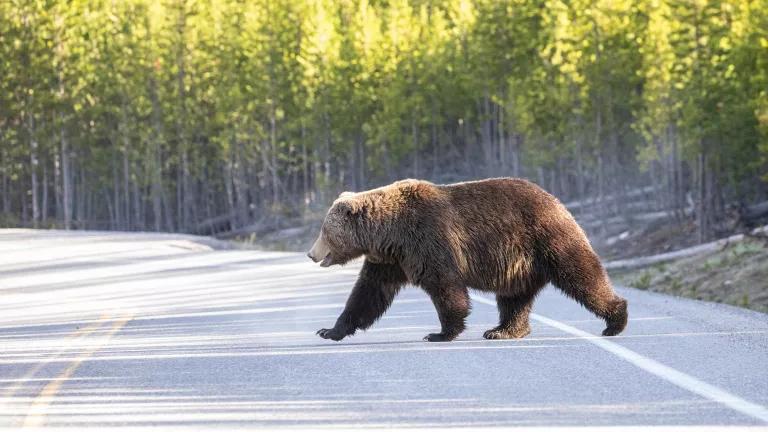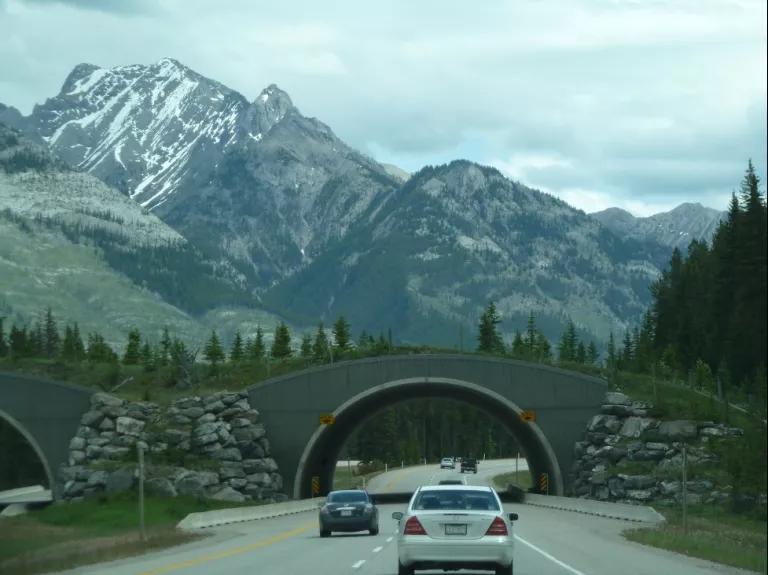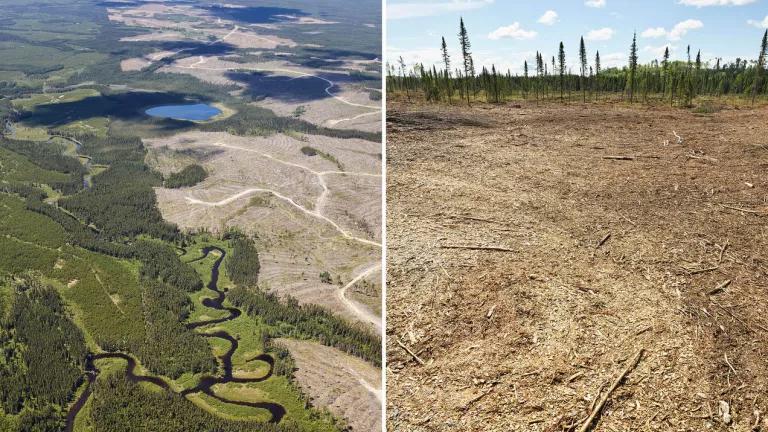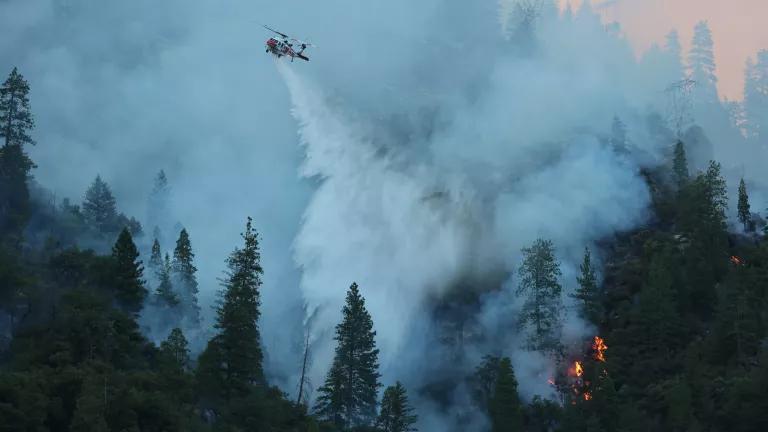
A grizzly bear crosses the road.
Wildlife move to survive. They amble, fly, slither, and swim to find food and water, establish territories, and ensure gene flow. A male grizzly bear’s home range can reach up to 600 square miles, Pacific salmon hatch in mountain streams then migrate to the ocean to be nourished before returning to their natal stream to spawn, and the intrepid monarch butterfly can travel as many as 3,000 miles making stops to feed on milkweed and other nectar sources along the way.
Wildlife movement is fraught with danger. As birds, fish and other wildlife move across the landscape they are vulnerable to weather events, predators, disease, and other natural threats. On top of that, wildlife struggle to successfully navigate around housing and infrastructure such as roads, energy development, and dams. If that wasn’t enough, climate change is impacting natural phenomena and shifting, for example, the availability of resources and the timing of migrations.
Addressing the biodiversity crisis will require transformative solutions that change the way we live and do business. Solutions need to come from all sectors and should ensure that wildlife have the room they need to roam. Their survival depends on it. To protect long-term connectivity, we need to do two things: 1) conserve areas that facilitate movement, and 2) reduce barriers to movement.i Congress has near-term opportunities to advance both goals.
Conserving areas that facilitate movement
Globally, as well as here in the United States, communities and governments are committing to protecting 30 percent of land, freshwater, and oceans habitat by 2030 (30x30). In May, the Biden Administration committed to this goal when it announced its America the Beautiful Campaign and the principles and recommendations it would follow. States are starting to make local commitments as well. 30x30 is an ambitious undertaking, and one that will only be successful if Indigenous nations, local communities, and other stakeholders are at the forefront of this work. It will require collaboration, local leadership, and home-grown solutions for conserving core habitats and the lands that connect them in perpetuity.
Identifying, designating, and developing management plans for connectivity areas is an essential part of the equation. In June, the Florida Legislature unanimously passed the Florida Wildlife Corridor Act “to create incentives for conservation and sustainable development while sustaining and conserving the green infrastructure that is the foundation of Florida’s economy and quality of life.” To support these efforts, $300 million was budgeted to protect the Florida Wildlife Corridor in addition to a proposed $100 million for the Florida Forever Program. Florida joins eight other states (OR, CA, UT, CO, NM, VA, VT, and NH) that have passed connectivity policies.
Members of Congress have called for national programs to designate and support locally and tribally led conservation efforts to ensure landscapes remain permeable for wildlife. The Tribal Wildlife Corridors Act supports tribal leaders who seek to designate wildlife corridors on tribal lands and directs federal agencies to work with tribes to develop conservation measures on adjacent federal lands. The Wildlife Corridors Conservation Act creates a National Wildlife Corridor System and provides for the designation and restoration of habitats that facilitate the movement of native species at risk due to habitat loss or fragmentation.

Migrating pronghorn in Wyoming.
The pronghorn’s 200-mile migration route between Grand Teton National Park and the Green River Valley in Wyoming is the longest land migration in the lower 48—it is called the Path of the Pronghorn. In 2008, the Bridger-Teton National Forest in Wyoming designated a pronghorn migration corridor on lands managed by the U.S. Forest Service and committed to managing the migration corridor to facilitate continued successful movement of pronghorn. Additional investments—including an overpass to facilitate pronghorn migration and conservation easements—have followed. Federal corridor legislation paired with state initiatives would pave the way for similar designations and the investments to make them successful.
Reducing barriers to movement
In addition to conserving key areas that facilitate wildlife movement, we must reduce or mitigate barriers that, if left unaddressed, will impede movement. Barriers come in many forms and include hard infrastructure such as roadways, low-quality stream crossings or insufficient culverts, and dams; subdivisions and other exurban development; and attractants including livestock, bee yards, and unsecured trash—that can lead to wildlife being killed in response to conflicts.
It is estimated that the one to two million wildlife vehicle collisions that occur annually in the United States result in millions of dead animals, tens of thousands of human injuries, and more than $8 billion dollars of damage and response costs.ii Luckily, steps can be taken to reduce such collisions, including building underpasses, overpasses, and directional fencing; alerting drivers to wildlife on the roads through signage and wildlife detection systems; and working at the local, state, and regional levels to incorporate wildlife needs into transportation planning. Countries in Europe began installing wildlife crossing structures in the 1950s to facilitate wildlife movement, and the use has spread. A partnership in Montana that includes the Confederated Salish and Kootenai Tribes, Montana Department of Transportation, and Western Transportation Institute provides a particularly good example of a series of structures that are facilitating wildlife connectivity across Highway 93, a busy transportation corridor.

Wildlife overpass along the Trans-Canada Highway in Banff National Park.
Barriers to movement can also take the form of human homes and activities that overlap with areas of importance to wildlife movement. For example, in the Northern Rockies, grizzly bears that travel in their home ranges may encounter the contents of an unsecured trashcan, backyard chicken coops, and vulnerable livestock that can provide them with a food reward they aren’t meant to have. Bears and other wildlife are often killed by wildlife managers in response to these types of conflicts. For years, NRDC has been supporting research and solutions to addressing grizzly bear-agricultural conflicts and advocating for more state and federal resources to ensure a safer landscape for people and wildlife.
Getting a move on wildlife connectivity
Proven solutions exist to ensure wildlife have the room they need to roam. Now, we need to implement them at scale. Here are three near-term actions Congress can take to meet the needs of wildlife and people:
- Support 30 by 30 by devoting federal resources for Indigenous nations and local communities to develop and implement solutions to protecting 30 percent of land, freshwater, and oceans by 2030.
- Pass the Tribal Wildlife Corridors Act and the Wildlife Corridors Conservation Act to set the stage for local corridor initiatives to be recognized and funded.
- Include funding in the federal infrastructure bill for wildlife crossing structures, safe fish passage, and pollinator habitat to facilitate wildlife movement.
i. Ament, R., R. Callahan, M. McClure, M. Reuling, and G. Tabor. 2014. Wildlife Connectivity: Fundamentals for Conservation Action. Center for Large Landscape Conservation: Bozeman, Montana.
ii. M.P. Huijser, P. McGowen, J. Fuller, A. Hardy, A. Kociolek, A.P. Clevenger, D. Smith and R. Ament. 2008. Wildlife-Vehicle Collision Reduction Study: Report to Congress. Federal Highway Administration: McLean, Virginia.



